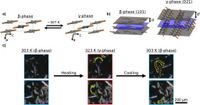In a groundbreaking study, researchers have employed diffracted X-ray blinking (DXB) to reveal critical dynamic behaviors of 1,2,4,5-tetrabromobenzene (TBB) and its polymorphs, shedding light on material properties that could revolutionize the field of mechanically responsive materials.
Polymorphism, where a substance can exist in multiple crystal structures, is an important characteristic that affects the physical properties of materials. TBB, known for its phase transition at approximately 307 K, demonstrates differing mechanical behaviors between its β-phase and γ-phase forms. In the latest study, scientists employed DXB to measure the subtle fluctuations in the d-spacing between lattice planes of TBB, concluding that these fluctuations occur at a significantly higher rate in the γ-phase compared to the β-phase. This finding adds depth to the understanding of TBB's polymorphic behavior by highlighting how molecular motion is affected by temperature variations, particularly near the phase transition.
The researchers, led by K. McGehee and collaborators from the High Energy Accelerator Organization in Japan, utilized powdered samples of TBB due to the ability to easily determine the phase under different conditions. Their setup consisted of grains sized approximately 6 μm x 13 μm, placed between two films to enhance data accuracy during X-ray diffraction measurements.
High-energy X-ray diffraction data were collected across varying temperature conditions, with findings indicating a spike in molecular motion rate as the phase transition temperature was approached. Remarkably, motion rates near 310 K reached values of 14.85 × 10−2 s−1, a significant increase indicative of underlying changes due to strain accumulation. This study also contextualizes previous findings of TBB’s thermosalient effect, where crystals exhibit jumping behavior upon heating, further displaying the implications of polymorphism in engineering materials with responsive capabilities.
DXB analysis proved to be a critical methodological advancement for understanding the dynamics of TBB. By fitting intensity fluctuations to exponential decay functions, the researchers identified unique molecular dynamics for different phases and temperatures, confirming the distinct characteristics associated with phase transitions. Similar analyses were tackled with emphasis on sample conditions, showing that the phase transition behavior could vary drastically with effective observation time during diffraction.
This research exposes the traditional limits of understanding polymorphic materials, as previous investigations often focused on steady-state characteristics. By employing DXB, scientists can now explore transient dynamics more effectively, paving the way toward innovative applications that may utilize these characteristics for developing new materials, particularly those engineered for responsiveness under varying stimuli. Researchers hope that findings like these will catalyze further exploration into the mechanistic understanding of crystalline structures and their behavior under duress.
As the study notes, polymorphism has implications not just for TBB, but can extend to broader classes of materials used in various industries, suggesting that these insights can lead to enhanced performances in drug delivery, structural integrity, and responsive design in materials science.
The findings presented here mark a meaningful advance in the characterization of polymorphic materials and offer a platform for future research aimed at unlocking the potential of more complex crystalline systems. These findings show the power of DXB in elucidating microscopic dynamics essential for manipulating mechanical properties in crystalline forms, providing essential knowledge needed for the design of next-generation responsive materials.




